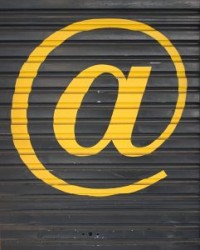 This post is inspired by Bob Poole’s post yesterday (Did You Just Sucker Punch a Potential Customer?)
This post is inspired by Bob Poole’s post yesterday (Did You Just Sucker Punch a Potential Customer?)
He compared spamming people (sending email to someone who didn’t ask for it, doesn’t want it, and doesn’t know you) to visiting a prospect and punching them in the nose when they open the door.
Not a good way to make a positive impression. And, when you’re a small business, you can’t afford that sort of mistake.
So, a few words about permission, list “rental,” list building, and how to stay out of the spam folder.
You need permission to email people
There are people (even marketing consultants) who think it’s OK to spam a big list “just once.” Or, to use a two-year-old list that they inherited from another company. I have even heard people say that it’s OK to send unsolicited emails as long as they’re text, but not HTML (huh?).
All bad ideas, and bad business email marketing.
Only use fresh email lists
Using names you got from a directory, a contact form, or a carbon copy is not permission. It’s also a waste of time and effort. The people on that directory list didn’t ask for spam, they signed up to get more visibility for their companies. You can ask people you contact you if they’d like to sign up, but don’t add them yourself. Sending marketing emails to people who were carbon copied on a project will also make you look bad.
An out-of-the-blue email from a company they never heard of will go straight to the spam folder.
CAN-SPAM doesn’t help
Yes, it’s technically legal to send email to people in the United States (but not Canada) without specific permission (the irony about CAN-SPAM is that it inadvertently created more spam).
However, the people who get it will think it’s junk. They will bounce it, mark it spam, blacklist the company that sent it, and after a while your messages won’t get through.
What do YOU do when you get email like that? Do you smile happily? Or do you hit that unsubscribe button as fast as you can?
What’s more, many people don’t see (or know about) unsubscribe options, so they hit the spam button instead. That will just make your reputation even worse.
Is a sucker punch the best way to make a good first impression? Is that the best way for a small business to run an email marketing campaign?
The truth about buying lists
Most email lists for sale are garbage. They’re often opted-in without real permission, using little pre-checked boxes on other forms (such as account signups). They offer to “send you offers from third parties.” What they really mean is that your email box will soon fill up with junk.
Plus, purchased lists are obsolete the minute you buy them. The older they get, the more out of date they will be. You’ll get more bounces, a lower delivery rate and a higher risk of being labeled a spammer.
Lists are like fish. The older they are, the more they stink.
The rented ones are better, but they’re expensive. B to B lists can be up to $350 per thousand names (minimum order 5,000 names). If someone is offering to send the list directly to you, run away.
Reputable list owners have their emails delivered by a third party. If they’re offering to send three times in one month, run even faster. That list has been burned out.
There is no such thing as a legitimate opt-in email list of 1,000,000 names for $100. They’re all lemons.
How to get permission to email
If you want to reach people, there are better ways than a sucker punch to build your list.
Here are a few of them:
- Write a helpful (not a sales pitch) article in a relevant magazine or newsletter (with a link to learn more about your services).
- Send out a press release.
- Offer a report of some kind (for free) to build up your list
- Send personal invitations to your prospects, asking if they would like to sign up (don’t sign them up yourself)
Don’t use your desktop email software
Outlook, Gmail, and Apple Mail are fine, but not for business email marketing. Use a professional email service (like AWeber or Mail Chimp). They will manage the opt-ins, opt-outs, and the bounces. You can also get tracking data (showing how many people received your email, the number of people who opened it, and how many clicked through to your web site). Plus, the delivery rate will be higher, as they’re a recognized, legitimate mailer.
There are more tips in my free Email Made Easy ebook. Download it here. No opt-in needed. Feel free to share it.
Image thanks to : pamah




